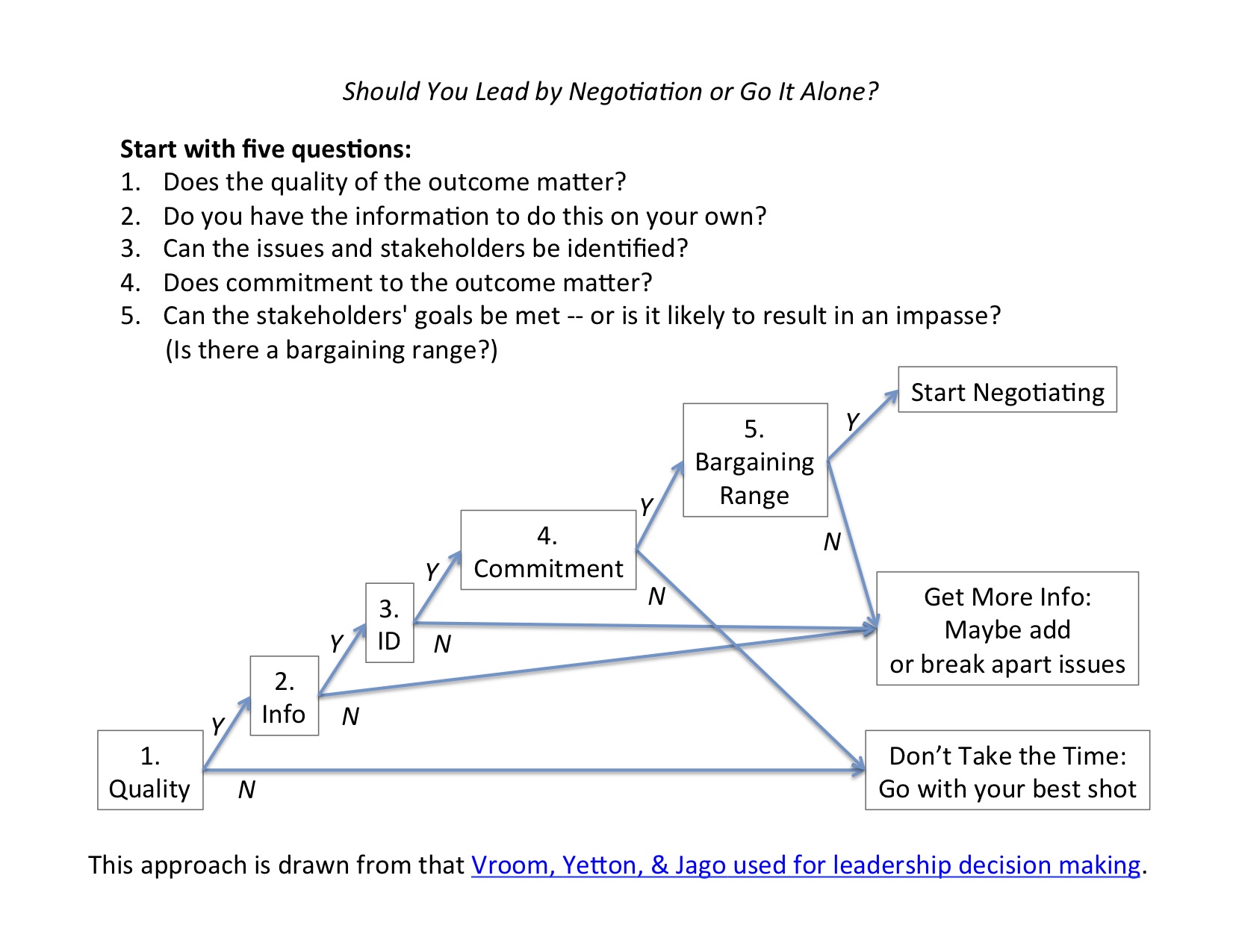Hack:
Lead by negotiation to create more powerful, engaging, and effective organizations
Everyone may not get everything they want, but they will get more of what they need and will understand the process that got them there.
We live and work in a world that is constantly changing in terms of the ways we communicate, collaborate, make decisions, find jobs, and entertain ourselves. Our organizations often need to operate globally, work jointly with other organizations to take on big tasks, and share research and results with employees, customers, clients, and partners as never before. The people inside our organizations are probably more diverse in terms of age, technological sophistication, and cultural background than just a few years ago.
To be effective in this changing world, we need to find ways to work and manage across all of the related organizational processes, technology tools, and people populating our workplaces. Can you keep all that in your head and come up with a great solution on your own? I know I can’t. If I tried, my single-perspective solution would likely be flawed and impossible to implement. Organizational and environmental complexity, as well as demands for transparency, require a more engaging approach to leadership and work.
The integrative approach means that as many issues as possible, from as many stakeholders as possible, are on the table at the beginning, are allowed to evolve throughout the process, and can be packaged or broken apart to create the most value.
- Begin by brainstorming about the stakeholders to the situation. Be inclusive - given the complexity of our world, you never know who will have a critical need or a spectacular idea. The detail you go into should parallel the importance of the situation. Low importance: Use these next steps as quick thought experiments. High importance: Get out the computer and open up the spreadsheet -- knowing that you’ll edit it over the course of the situation.
- List the stakeholders across the top of a spreadsheet. Spreadsheets are great as they can be edited to add rows or columns as you learn more about the situation.
- For your own preparation, begin a list of likely “issues” (things that stakeholders would care about and need to bring to the table). Be sure to consider issues related to all of the:
- People involved -- who they are, their training, their preferences
- Technology tools -- everything from electronic to physical (like conference room space). Are these tools that you have or might need? What are their cost and support needs?
- Organizational processes -- standard operating procedures that might need to be adjusted, new policies that could help, work flows to adjust, choke points to get around.
- Think about each stakeholder and list the possible issues down the left side of the spreadsheet.
- Still working on your own preparation, add rows under each issue for the different possible outcomes that could occur related to that issue. These include the outcomes you hope you reach, and those you hope you don’t. Be sure to put yourself in the other stakeholders’ shoes as you think about these options.
- Next step is to write-in estimated responses for each of the issue/outcome/stakeholder cells. To keep it simple stick to four categories: neutral (don’t care), strongly for or against, moderately for or against, deal breaker/maker (use this one rarely, if at all).
- You’ve now done your basic preparation -- the issues are “on the table” and you are ready to being negotiating - whether or not you call it that. As others come to understand this approach, have everyone draft a spreadsheet and then start discussing your drafts to tighten up the predictions and estimates. It’s often interesting to see how far off people’s estimates of other stakeholders’ preferences are. This is a great way to increase understanding.
The goal is to increase the value from a decision that any one person would have come up with on their own or from what would have happened from a different style of decision building. Have a bias toward trade-offs versus compromise. Compromises leave everyone with less than what they want. Trading off lower value outcomes on one issue in return for a big value outcome on a different issue generally creates more value overall.
Everyone may not get everything they want, but they will get more of what they need and will understand the process that got them there. Commitment to the decision will be higher as the stakeholders were publicly involved, participated voluntarily (hopefully), and if there’s a handshake, a kiss, or a “so help me God” at the end, there is an expectation that the deal is set. (There is a reason weddings and swearing-in ceremonies follow the same public, voluntary, hard to get out of procedures -- these are great behaviors to create commitment.)
Leading by negotiation gets a running start since we already know the basic skills of negotiation.

A very interesting approach. It could be a sound start in promoting corporate strategy as everyone’s business. What I like the most of this hack is the fact that invite us to think about others during the ideation/preparation process. As terry wrote: "be sure to put yourself in the other stakeholders’ shoes"
- Log in to post comments
- Log in to post comments
I really like this approach. It reminds me a bit of some elements of design thinking (and actually a bit of the process I use for problem solving/solution building at Red Hat), but I've never considered actually framing the discussion as a negotiation. I've learned that it's often impossible to get "consensus" but that it can be feasible to reach an agreement. This is a great framework for that.
On the question of when to collaborate vs. when to make a decision, I find in my work that often the facilitator of the discussion needs to insert themselves to either push for a decision or re-cap the consensus view and move on. When people get into the heat of discussion they may forget about the outcome and just keep re-hashing the same points.
I'd love to see the hack on decision making!
- Log in to post comments
- Log in to post comments
Interesting approach. Approaching solution innovation and implementation through allowing the ideas to grow and thrive in a healthy environment definitely ensures that the most value is put into each idea on the table, which should lead to the best ideas.
But I'm curious about another point. Did any of your reading lead to any guidelines of when to utilize collaborative negotiation versus competitive negotiation versus quick, fast and unilateral decisions? Has collaborative negotiation been found to be a universal tool that fits every situation?
I'm thinking about the times when time is of the essence and teams have already bubbled the best ideas up to the considered. In my mind, there is a time/value trade off with solutions that have a value half-life.
I heard a random number thrown out at a conference, something like only 10% of decision within a high caliber company really need to undergo deliberation. The other 90% simply need ANY decision (within reason).
Also, do you find that collaborative negotiation works in groups with highly innovative and passionate teams? Seems like this could get pulled into a never ending loop of project plugs and incremental improvement budget increases. When you have competing ideas that have fundamental differences, must one switch to competitive negotiations after a series of collaborate negotiation sessions to begin cutting the ideas that didn't quite make the grade, or is this also part of the collaborative process?
I will definitely need to brush up on collaborative negotiation. Thank you for your contribution!
- Log in to post comments
- Log in to post comments
- Log in to post comments
- Does the quality of the outcome matter?
- Do you have the information to do this on your own?
- Can the issues and stakeholders be identified?
- Does commitment to the outcome matter?
- Can the stakeholders' goals be met -- or is it likely to result in an impasse?
- Log in to post comments
- Log in to post comments







You need to register in order to submit a comment.